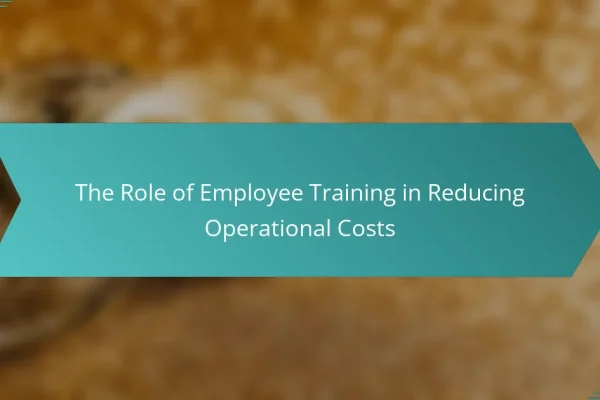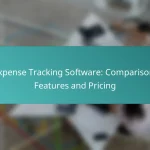What are effective cost reduction techniques for corporate expense management?
Effective cost reduction techniques for corporate expense management focus on streamlining processes, leveraging technology, and optimizing vendor relationships. By implementing these strategies, companies can significantly lower their operational costs and improve overall financial health.
Implementing automated expense tracking software
Automated expense tracking software simplifies the process of managing corporate expenses by digitizing receipts and categorizing spending. This technology reduces manual entry errors and provides real-time insights into spending patterns, allowing for quicker adjustments to budgets.
When choosing software, consider features such as integration with existing accounting systems, user-friendliness, and mobile access. Many solutions offer tiered pricing based on the number of users, which can range from affordable monthly subscriptions to more comprehensive enterprise solutions.
Negotiating better vendor contracts
Negotiating better vendor contracts can lead to significant savings on essential services and supplies. Companies should regularly review existing contracts and compare them against market rates to identify opportunities for renegotiation.
Engaging multiple vendors in the negotiation process can create competitive pressure, often resulting in better terms. Aim for longer contract durations in exchange for lower rates, but ensure that the terms remain flexible to adapt to changing business needs.
Encouraging remote work to reduce overhead
Encouraging remote work can substantially reduce overhead costs associated with office space, utilities, and supplies. By allowing employees to work from home, companies can downsize their physical office footprint, leading to lower rent and maintenance expenses.
To implement this strategy effectively, provide employees with the necessary tools and technology for remote collaboration. Consider a hybrid model that balances remote and in-office work, which can maintain team cohesion while still cutting costs.
Utilizing cloud-based solutions for scalability
Cloud-based solutions offer scalable resources that can grow with a business, reducing the need for significant upfront investments in hardware and software. These solutions typically operate on a pay-as-you-go model, allowing companies to only pay for what they use.
When adopting cloud services, evaluate options based on security, compliance with regulations, and ease of integration with existing systems. This approach not only cuts costs but also enhances flexibility and responsiveness to market changes.
Conducting regular expense audits
Regular expense audits help identify unnecessary expenditures and ensure compliance with company policies. By systematically reviewing expenses, businesses can uncover trends and areas where costs can be trimmed or eliminated.
Establish a routine for audits, such as quarterly reviews, and involve multiple departments to gain comprehensive insights. Use findings to adjust budgets and implement stricter controls on spending, fostering a culture of financial accountability within the organization.
How can companies leverage technology for expense management?
Companies can leverage technology for expense management by utilizing software solutions that automate tracking, reporting, and analysis of expenses. This approach enhances accuracy, reduces manual errors, and provides real-time insights into spending patterns.
Using AI-driven analytics for spending insights
AI-driven analytics can transform expense management by analyzing large volumes of spending data to identify trends and anomalies. These insights help companies make informed decisions about budgeting and cost reduction strategies.
For example, AI tools can flag unusual spending behaviors or suggest areas where costs can be cut, such as recurring subscriptions that are underutilized. By implementing these analytics, businesses can achieve cost savings of 10-20% over time.
Integrating expense management tools with ERP systems
Integrating expense management tools with ERP (Enterprise Resource Planning) systems streamlines financial processes and enhances data accuracy. This integration allows for seamless data flow between departments, reducing the time spent on manual data entry and reconciliation.
Companies should consider selecting expense management solutions that offer compatibility with their existing ERP systems. This ensures that all financial data is centralized, making it easier to track expenses and generate reports efficiently.
What are the benefits of a centralized expense management system?
A centralized expense management system offers significant advantages, including enhanced control over company spending and improved efficiency in processing expenses. By consolidating all expense-related activities, organizations can better monitor expenditures and enforce policies effectively.
Improved visibility into spending patterns
Centralized expense management provides a comprehensive view of spending across departments, allowing businesses to identify trends and anomalies. This visibility helps in making informed decisions about budget allocations and identifying areas for cost reduction.
For example, a company might discover that travel expenses are consistently higher in certain departments, prompting a review of travel policies or vendor contracts. Regular reporting can highlight these patterns, enabling proactive management.
Streamlined approval processes
With a centralized system, the approval process for expenses becomes more efficient, reducing delays and improving turnaround times. Automated workflows can ensure that requests are routed to the appropriate approvers without unnecessary back-and-forth communication.
Implementing predefined approval hierarchies can simplify the process further. For instance, low-value expenses might require only one approval, while higher amounts could necessitate multiple levels of authorization, thus balancing speed and oversight.
Enhanced compliance and policy enforcement
A centralized expense management system strengthens compliance with company policies and regulatory requirements by standardizing procedures. This ensures that all employees adhere to the same guidelines, reducing the risk of errors or fraudulent claims.
Regular audits and automated checks can help maintain compliance. For example, the system can flag expenses that exceed predefined limits or do not align with company policies, allowing for timely corrections and reducing potential liabilities.
What criteria should companies consider when choosing expense management software?
Companies should consider scalability, user-friendliness, and integration capabilities when selecting expense management software. These factors ensure that the software can grow with the business, be easily adopted by employees, and work seamlessly with existing systems.
Scalability to accommodate business growth
Scalability is crucial for expense management software as it allows the system to handle increased transaction volumes and additional users as the company expands. Look for solutions that can support a growing number of employees and transactions without significant performance degradation.
Consider software that offers tiered pricing models, allowing you to pay for only what you need at any given time. This flexibility can help manage costs effectively while ensuring the software remains aligned with your business needs.
User-friendly interface for employee adoption
A user-friendly interface is essential for ensuring that employees can easily navigate the expense management software. An intuitive design reduces the learning curve and encourages compliance with expense reporting policies.
Choose software that offers features like mobile access and simple submission processes. This can significantly enhance user experience and increase the likelihood of timely and accurate expense reporting.
Integration capabilities with existing systems
Integration capabilities are vital for ensuring that the expense management software works well with your current financial and operational systems. Look for solutions that can connect with accounting software, payroll systems, and other critical applications.
Evaluate the ease of integration and whether the software supports APIs or pre-built connectors. This can save time and resources during implementation and help maintain data consistency across platforms.
What are common pitfalls in corporate expense management?
Common pitfalls in corporate expense management include inadequate employee training on policies and the failure to regularly review and update those policies. These oversights can lead to inefficiencies, increased costs, and compliance issues.
Neglecting to train employees on policies
Failing to train employees on expense management policies can result in misunderstandings and non-compliance. Employees may submit incorrect or inappropriate expenses, leading to unnecessary costs for the company.
To avoid this pitfall, organizations should implement regular training sessions and provide accessible resources that clearly outline expense policies. Consider using interactive tools or workshops to engage employees and reinforce understanding.
Failing to regularly review and update expense policies
Expense policies that are not regularly reviewed can become outdated, failing to reflect current business practices or regulatory requirements. This can lead to inefficiencies and potential legal issues.
Companies should establish a routine review process, ideally annually, to assess and update expense policies. Involve key stakeholders in this process to ensure the policies remain relevant and effective. Additionally, communicate any changes promptly to all employees to maintain compliance and clarity.
How can companies measure the effectiveness of their expense management strategies?
Companies can measure the effectiveness of their expense management strategies by tracking key performance indicators (KPIs) such as cost savings and employee compliance rates. Regular analysis of these metrics allows organizations to identify areas for improvement and ensure that their expense management processes are driving financial efficiency.
Tracking cost savings over time
To effectively track cost savings, companies should establish a baseline of their expenses before implementing any management strategies. By comparing current spending against this baseline, organizations can quantify savings achieved through various initiatives.
It’s beneficial to categorize expenses into fixed and variable costs, as this helps in pinpointing which areas yield the most significant savings. Regular reviews, perhaps quarterly, can help maintain focus on cost reduction efforts and adjust strategies as necessary.
Analyzing employee compliance rates
Employee compliance rates are crucial for assessing how well staff adhere to expense policies. Companies can measure compliance by reviewing submitted expense reports against established guidelines and identifying any discrepancies.
Implementing automated tools can streamline this process, allowing for real-time monitoring of compliance. Providing training and clear communication about expense policies can also enhance adherence, ultimately leading to more effective expense management.






